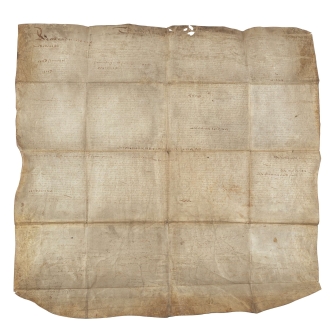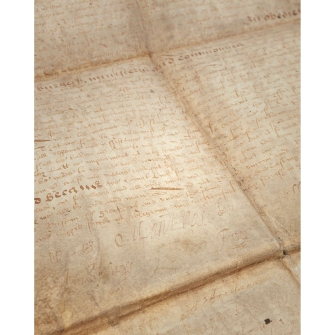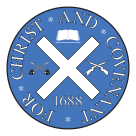



Peebles Covenant
The copy of the National Covenant that was subscribed in Peebles was owned privately until 2024, when it came up for auction. We are grateful to auctoneers, Lyon & Turnbull, for permission to use the following description and history of the document, as well as the pictures of it.
Description : manuscript, ink on single sheet of vellum (67.5 x 69.5cm), main declaration on recto and Glasgow Determination on verso, each written in a separate secretarial hand, autograph signatures of some 20 noblemen directly below main declaration including Rothes, Montrose, Eglinton, Cassilis, Home, Drumlangrig, Montgomery, Yester, Wemyss, Boyd, Flemyng, Forrester, Balcarres, Johnstoun, Balmerino, Lindesay, Elcho, Fraser, Dalzell and others, numerous further signatures including those of Peebles subscribers below both main declaration and Glasgow Determination, contemporary manuscript endorsement ‘The Confession of Faith for the Burgh of […]' (the final word illegible, an initial ‘P’ possibly present), the date ‘1638’ to endorsement and head of main declaration perhaps added later, two additional annotations (both 19th century) to verso recording provenance.
Condition: dust-soiled, old stretch-holes to head from flaws in the vellum, a few other small holes, fading to signatures
Provenance:
1) Gavin Veitch of Peebles, by whom bequeathed in 1802 to
2) Thomas Henderson, ‘dissenting minister’, identified as Thomas Henderson (1757-1823), Reformed Presbyterian minister at Kilmacolm, Renfrewshire (see Couper, p. 89)
3) Adam Brown (c.1768-1834), Reformed Presbyterian minister at Crookedholm, then Kilmarnock, Ayrshire, son-in-law of Thomas Henderson via his marriage to Jessie Henderson, second daughter of Thomas Henderson (see Scots Magazine, LXXII, p. 958, and McKay p. 221), thence by descent to
4) James Brown of Kilmarnock, by whom sold in 1906 for £20 to
5) William Henderson Walker (1855-1923), of Chorlton Hall, Cheshire, chartered accountant and descendant of Thomas Henderson of Kilmacolm
6) Thence by descent
Footnote
A rediscovered original copy of one of the principal documents in the history of Scotland, one of a handful remaining in private ownership, and the fourth known copy to appear at auction.
After ‘foor principal copyes in parchment’ of the National Covenant were made during the night of 28 February and 1 March 1638, it was decreed on 2 March that further copies would be made for distribution to every shire, baillery and stewartry in Scotland, to be signed by the principal figures within each jurisdiction. Many hundreds were doubtless produced, but in the most recent census of surviving copies David Stevenson records a total of 74, all but 14 being in institutional collections, and nearly all in Scotland, noting that these ‘doubtless represent only a small fraction of the original total; to the normal ravages of time there must be assumed to have been added deliberate destruction of many when, after 1660, having signed the covenant became an embarrassment, retaining possession of a copy a liability’ (Stevenson, p. 260).
The identities of the local notables subscribing to the present copy indicate that it was intended for the burgh of Peebles. The National Library of Scotland holds a copy of the National Covenant described as containing the signatures of the ‘provost, bailies, and councillors of the burgh of Peebles, [and the] burgesses of Jedburgh’ (Adv.MS.20.6.16). David Stevenson notes that David Laing in his 19th-century census ‘refers to a covenant “belonging to the burgh of Peebles” marked “For the Burgh of Peebles” which had been engraved in facsimile. The reference to a facsimile indicates that it is this covenant now in the NLS that Laing refers to, but the inscription … is not present, making it possible that there is – or was – a second Peebles covenant’ (Stevenson p. 271).
The existence of two Peebles copies may be connected to the contested reception of the National Covenant in the region, illustrating that the document’s acceptance was not a foregone conclusion across Scotland, contrary to the drift of much subsequent historiography. As a leading modern historian of the covenanters has noted: ‘While some communities were enthusiastic early endorsers of the Covenant, others appear to have quietly ignored it until a decision was forced upon them … The presbytery of Peebles, in the Scottish borders, counted the earl of Traquair amongst its flock, and not surprisingly, became one of the comparatively few to endorse the rival king’s covenant in the autumn of 1638. The National Covenant was finally accepted in May 1639, but only after some of the brethren had insisted on “a sight” of the relevant acts of synod and general assembly’ (Stewart, p. 108).
The Peebles subscribers whose signatures are visible on this copy include J. Peter, commissar of Peebles, various burgesses, baillies and counsellors, and several figures whose local status is not mentioned but who can be identified from secondary sources. Among the latter are two individuals of special interest, namely one Andrew Watson and one P. Purdie of Newlands. An Andrew Watson is recorded as vicar of Peebles and in 1652 received ‘£3 Scots as part payment due by the Presbytery for burning witches’ (Chambers, p. 166); Patrick Purdie, minister at Newlands from 1634 to 1681, was involved in at least three witch trials in the 1640s.
In addition to the known extant copies of the National Covenant, Stevenson lists 20 under the heading ‘missing, lost or suppositious’. The present copy may account for that recorded as 16.19, described on the basis of letters in the Scottish Record Office (now the National Records of Scotland) as having been owned at some point in the 19th century by a Mrs Landells, wife of one Thomas Henderson, and eventually given to a ‘Mr Brown’, nephew of Thomas Henderson. Another copy, recorded as 16.1, is one apparently signed at Kilmarnock and seen in Cheshire; the report, described by Stevenson as ‘doubtful’, may be a confused account of the Kilmarnock-Cheshire provenance of the present copy.
A copy of the National Covenant subscribed in Renfrew was sold by Lyon & Turnbull in 2009 (10 June lot 251). In 1977 Sotheby’s sold two copies: one subscribed in Echt, Aberdeenshire, and a decorative copy signed by the organising noblemen but not intended for local subscription.
The lot sold with associated documents including: letter from Adam Brown to Thomas Henderson, Kilmarnock, 1830; Fr. Schenck, Fac-Simile of the National Covenant of Scotland, in its original form with the Autographs of the principal leading Personages (lithographic facsimile on paper, in 20 sections, laid on linen, folding into cloth covers, front cover detached); ‘The Confession of the Faith, or National Covenant of Scotland, contributed by Mrs. Brown, Kilmarnock, Ayrshire’ (printed exhibition caption, mid-19th century); receipt of payment of £20 from W H. Walker of Chorlton Hall to James H. Brown ‘for the national covenant’ dated 10/9/06.





